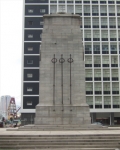The Cenotaph
Archaeology »
Archaeological Monuments » The Cenotaph
The Cenotaph -
The Cenotaph is located in Statue Square, Central.
The Cenotaph monument was established on 1923.
Primary threats to The Cenotaph :
During British rule and after 1945, Liberation Day celebration took place here on the last Monday in August to commemorate the Liberation of Hong Kong from Japanese occupation in 1945.
Historical facts of The Cenotaph :
- The Cenotaph, located in London's Whitehall, is one of the most iconic war memorials in the world. It serves as a symbol of remembrance and reverence for the millions of British and Commonwealth soldiers who lost their lives in World War I, World War II, and subsequent conflicts. This timeless monument holds historical significance and has become a focal point for national commemorations and ceremonies. Here are some historical facts about The Cenotaph:
- Origin and Design :
The concept of The Cenotaph was first introduced by Sir Edwin Lutyens, one of the most renowned architects of his time. Lutyens was commissioned to design a temporary wood and plaster cenotaph for the Victory Parade in London in July 1919, celebrating the end of World War I. The term "cenotaph" originates from the Greek words "kenos" (empty) and "taphos" (tomb), symbolizing an empty tomb to honor the fallen whose remains lie elsewhere.
- Temporary to Permanent :
Due to its overwhelming impact and the outpouring of public support, the temporary cenotaph was recreated in Portland stone and unveiled on Armistice Day, November 11, 1920. It was intended as a temporary structure, but its poignant symbolism and emotional resonance with the public led to the decision to make it a permanent memorial.
- World War I Commemoration :
The Cenotaph was initially dedicated to the memory of those who lost their lives in World War I. It was envisioned to be a focal point for national mourning and reflection, and over the years, it has come to represent all British and Commonwealth service personnel who died in subsequent conflicts.
- The Remembrance Day Ceremony :
Since its inauguration, The Cenotaph has been the central focus of the national Remembrance Day ceremony held annually on the closest Sunday to November 11th. This ceremony pays tribute to the fallen soldiers of World War I and all subsequent conflicts. The event is attended by members of the Royal Family, veterans, dignitaries, and the public, who gather to observe a two-minute silence as a mark of respect and gratitude.
- Additions and Inscriptions :
Over time, additional inscriptions have been added to The Cenotaph to remember those who perished in World War II and other conflicts. Following World War II, the dates "1939-1945" were engraved on the sides of the monument, expanding its significance to encompass the fallen from both World Wars.
- Replicas Around the World :
The Cenotaph's design and symbolism have inspired the creation of numerous replicas in other countries. Many Commonwealth nations have their versions of The Cenotaph, serving as local memorials and places of remembrance.
- Public Mourning :
Throughout history, The Cenotaph has witnessed numerous moments of national mourning and public expression of grief. Notably, during the funeral of Sir Winston Churchill in 1965 and the funeral of Diana, Princess of Wales, in 1997, the monument became a focal point for the expression of collective sorrow and tribute.
- Restoration :
Over the years, The Cenotaph has undergone various restoration projects to preserve its architectural integrity and historical significance. The most extensive restoration was carried out in 2017, as part of the government's efforts to mark the centenary of World War I.
- Conclusion :
The Cenotaph in Whitehall stands as a symbol of remembrance and gratitude, representing the sacrifice of countless soldiers who gave their lives in the service of their country. Its simple yet powerful design has become an enduring symbol of national mourning, resilience, and unity. As a focal point for commemorations and ceremonies, The Cenotaph serves as a poignant reminder of the profound impact of war on society and the importance of remembering and honoring those who have made the ultimate sacrifice for peace and freedom.

